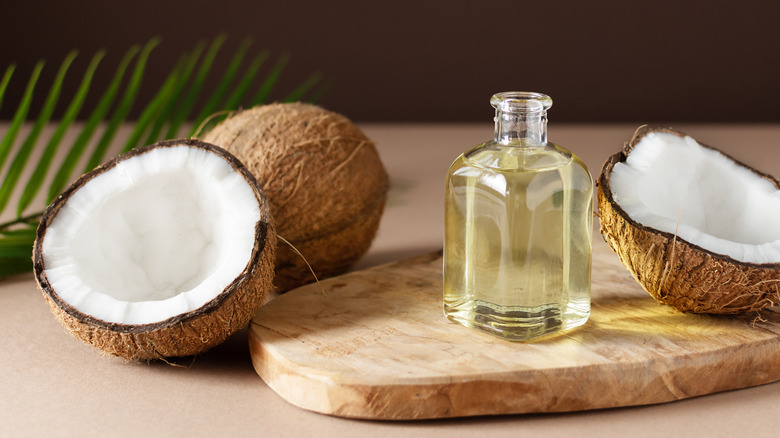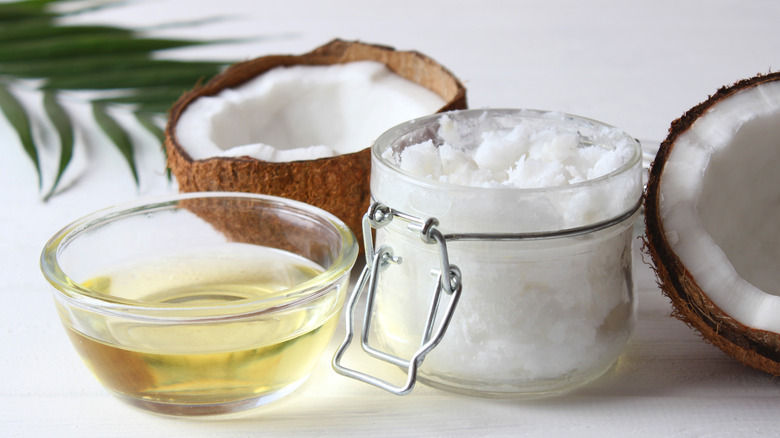Is It Safe To Use Coconut Oil To Help Cure Yeast Infections?
When you experience itchiness and pain in your intimate area, you probably want to do anything you can to make it go away ASAP! Yeast infections are a common reason for vaginal itchiness, in addition to other very uncomfortable symptoms. The Centers for Disease Control and Prevention (CDC) reports that approximately 1.4 million Americans are seen by healthcare professionals to treat yeast infections every year, which means that you definitely aren't alone if you've had the unpleasant experience of having a yeast infection. Medical treatments include prescriptions like oral fluconazole and antifungal creams that can be purchased over the counter (OTC). If you're looking for a more holistic approach, or you simply want to know if there are other treatment options out there that will help a yeast infection resolve as quickly as possible, the good news is that other remedies do exist.
Coconut oil is one such holistic method that is used for a variety of purposes due to its health benefits. Per Healthline, coconut oil possesses antifungal and antimicrobial properties due to having high concentrations of medium-chain triglycerides (MCTs). The MCTs in coconut oil have been found to be effective in treating symptoms of epilepsy, autism spectrum disorder, and Alzheimer's disease. Coconut oil can also improve the health quality of skin, hair, and brain function as well as boost energy. And yes, the antifungal nature of coconut oil's MCTs has been proven effective in healing yeast infections. Here's what to know about yeast infections, coconut oil, and applying this method safely.
The relationship between coconut oil and yeast infections
Yeast infections aren't just limited to intimate areas of the body. According to MedicalNewsToday, they can develop in some pretty surprising places, such as the mouth. Yeast infections can develop on any patch of skin, on the nipples of women currently breastfeeding, and on genitalia. The infections are actually caused by a fungus called Candida, and it is the Candida species of fungus that yeast infection treatments target when trying to rid the body of the infection. A 2007 study published in the Journal of Medicinal Food found that coconut oil can effectively fight Candida species that are resistant to medicinal drugs, as well as forms of the fungus that instigate yeast infections.
Coconut oil comes from the meat of coconuts and is comprised of the fatty oil squeezed out of the flesh of the fruit (via Healthline). At present, there aren't any known adverse effects of using coconut oil to treat yeast infections, though more research is needed to understand the long-term effects of applying coconut oil to the body. For now, the antimicrobial and antifungal properties of coconut oil have been proven effective holistic means for treating yeast infections. To apply coconut oil to an area affected by Candida overgrowth, start by rubbing a small amount of the oil directly onto your body. Make certain that you're using coconut oil that's labeled organic and contains 100% coconut oil without added ingredients.
Safely utilizing coconut oil for yeast infection treatment
After ensuring that you've purchased organic coconut oil without added ingredients, knowing the proper amounts to apply to various body parts can streamline the process. To safely use coconut oil to treat yeast infections, there are different recommendations for respective parts of the body, per Healthline. For yeast infections within the vaginal area, you can either apply coconut oil directly to the area by rubbing it in with clean hands, or you can rub coconut oil onto a clean tampon to be inserted into your vagina. Yeast infections in the mouth can be safely treated by placing up to two tablespoons of pure coconut oil into your mouth and moving it around like mouthwash. However, unlike mouthwash that is generally only kept in the mouth for about a minute, recommendations for fighting yeast infections suggest keeping the coconut oil swishing in your mouth for 15 to 20 minutes, then spitting it out and waiting at least half an hour before consuming or drinking anything else.
Coconut oil can be combined with other yeast infection treatments to clear the infection quickly and completely, so always consult with your doctor for professional instructions on which treatment methods should be used in tandem.
If you are allergic to coconut oil, you should avoid using it to treat a yeast infection. MedicalNewsToday recommends other holistic methods like applying tea tree oil or organic oregano oil and eating lots of yogurt alongside probiotic-rich foods and supplements.


